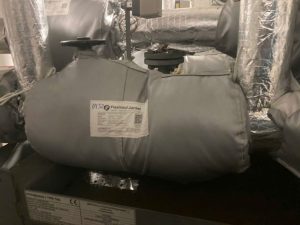Insulation jackets (also known as insulation bags or removable insulation blankets) are a flexible and effective thermal solution for industrial machinery and piping systems. However, common misconceptions about their cost, effectiveness, and applications cause many businesses to miss opportunities to optimize energy and operational costs.
This article will clarify the 5 most common misconceptions, helping you gain a correct understanding and make more effective investment decisions.
5 Common Misconceptions About Industrial Insulation Jackets
Misconception 1: “The initial cost is too high and not worth the investment”
The perception of cost is one of the biggest barriers causing many businesses to hesitate.
- The Truth: The initial investment for insulation jackets can be higher than traditional insulation materials (like fixed mineral wool). However, it is a long-term investment that offers dual benefits:
- Energy Savings: Insulation jackets effectively reduce heat loss, significantly cutting energy costs for boilers, heating systems, pipelines, etc. The return on investment (ROI) is often very fast, ranging from a few months to under two years, depending on the specific application.
- Reduced Maintenance Costs: Because they can be easily removed and reinstalled in minutes, inspecting and maintaining valves, joints, and equipment becomes quick. Businesses no longer incur the cost and time of removing and reinstalling fixed insulation for every maintenance task.
Misconception 2: “Insulation jackets aren’t as durable as fixed insulation”
Many people assume that because they are flexible and removable, insulation jackets are less durable and more prone to damage.
- The Truth: The durability of an insulation jacket depends entirely on the quality of its materials and construction.
- Specialized Materials: A high-quality insulation jacket is made from advanced technical fabrics (fiberglass, ceramic, silica cloth) coated with silicone, Teflon (PTFE), etc., which can withstand high temperatures, chemicals, oil, and harsh weather.
- Robust Design: Details like fastening straps, D-rings, and hooks are typically made from stainless steel, ensuring durability and security even in tough industrial environments. A properly designed product can have a lifespan of many years.
Misconception 3: “Only extremely hot surfaces need insulation jackets”
Some businesses only focus on insulating very high-temperature equipment like boilers, overlooking other areas.
- The Truth: Any surface with a temperature difference from the ambient environment causes energy loss and poses a potential safety risk.
- Versatile Applications: Insulation jackets are used not only for heat retention (hot insulation) but also for cold insulation in chiller systems and air conditioning ducts. This helps prevent condensation, corrosion, and cold loss.
- Workplace Safety: Even surfaces that are not extremely hot (around 60°C – 70°C) can cause burns upon accidental contact. Installing insulation jackets creates a safer working environment for employees.
Misconception 4: “They are not as thermally efficient as traditional materials”
Due to their flexibility, many doubt the insulating capability of jackets compared to fixed insulation with mineral wool and cladding.
- The Truth: The thermal performance of an insulation jacket is comparable, and can even be superior, if designed and installed correctly.
- Snug Fit Design: Each insulation jacket is custom-designed and sewn to the exact dimensions of the specific equipment (valves, flanges, elbows, pumps, etc.). This ensures a tight fit, eliminating thermal bridges and air gaps, thus maximizing insulation efficiency.
- High-Performance Core Materials: The inner insulation core is typically made of high-performance materials like ceramic fiber, glass wool, or aerogel, which have excellent thermal insulating properties.
Misconception 5: “All insulation jackets are the same”
Choosing cheap, unbranded products can lead to a misjudgment of the overall quality and effectiveness of this solution.
- The Truth: The quality, performance, and durability vary greatly among different insulation jackets on the market.
- Customized for the Application: A reputable supplier will survey the site and recommend the appropriate materials, thickness, and design for each specific application, based on factors like operating temperature, indoor/outdoor environment, chemical resistance requirements, etc.
- Making the Right Choice: Choosing the wrong material can cause the jacket to fail prematurely, lose thermal efficiency, and even create safety hazards. Therefore, partnering with experienced and knowledgeable suppliers is crucial.
Conclusion
Industrial insulation jackets are a smart investment that provides long-term benefits in energy savings, reduced maintenance costs, and improved workplace safety. Understanding the product correctly will help businesses confidently choose the most suitable solution to optimize their operational efficiency.
Request consultation and quotation now!Frequently Asked Questions
What is an industrial insulation jacket?
It is a thermal insulation cover designed for easy removal and installation, used on equipment like valves, pipes, and pumps to reduce heat loss, save energy, and ensure safety.
Is the investment cost for insulation jackets high?
The initial cost may be higher than fixed insulation, but thanks to energy savings and reduced maintenance costs, the payback period is often very short, making it a cost-effective long-term investment.
Are insulation jackets durable?
Very durable. If made from high-grade technical fabrics (fiberglass, ceramic cloth coated with silicone/Teflon) and properly manufactured, an insulation jacket can last for many years in harsh industrial environments.
When should you use insulation jackets instead of fixed insulation?
Insulation jackets are the ideal choice for equipment, valves, and fittings that require periodic inspection or maintenance, as they can be quickly removed and reinstalled without damaging the insulation.
What equipment can insulation jackets be used for?
They can be customized for almost any piece of equipment: valves, flanges, pipes, elbows, tees, pumps, heat exchangers, tanks, and more, in both hot and cold systems.
How do I choose the right type of insulation jacket?
You should work with a reputable supplier. They will assess the temperature, operating environment, and equipment dimensions to recommend the most suitable materials, thickness, and design for your insulation jacket.










